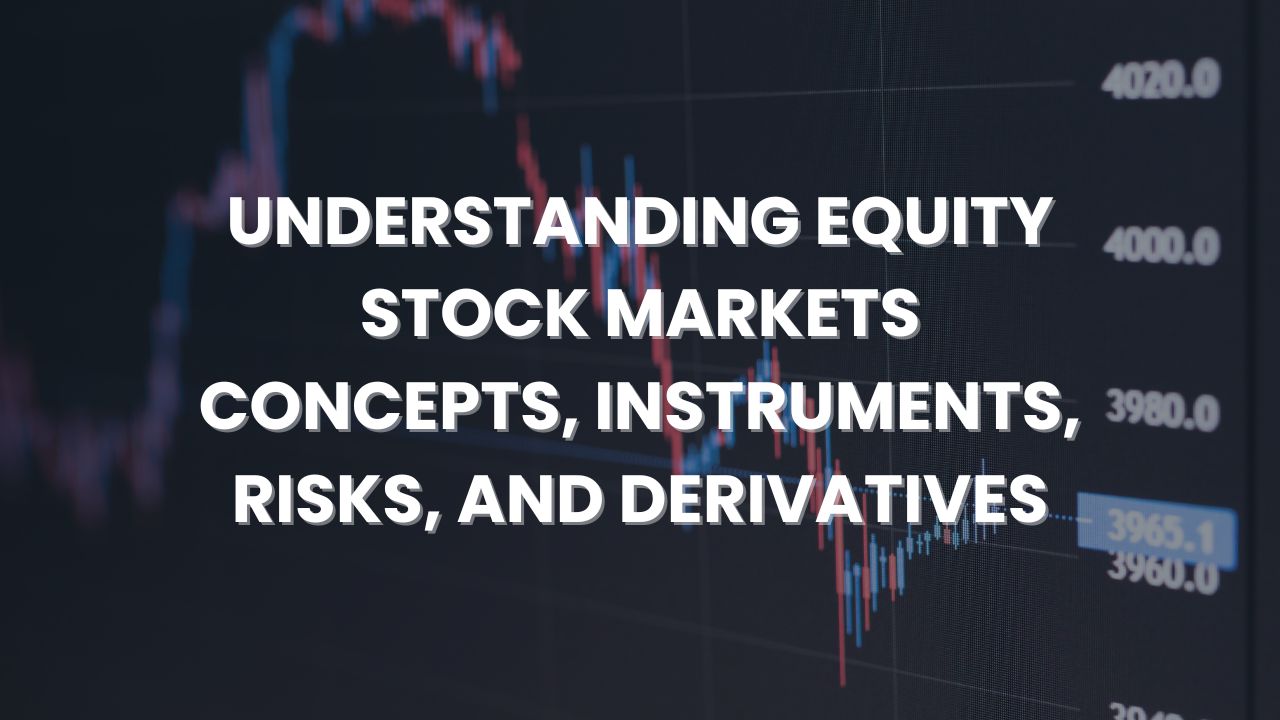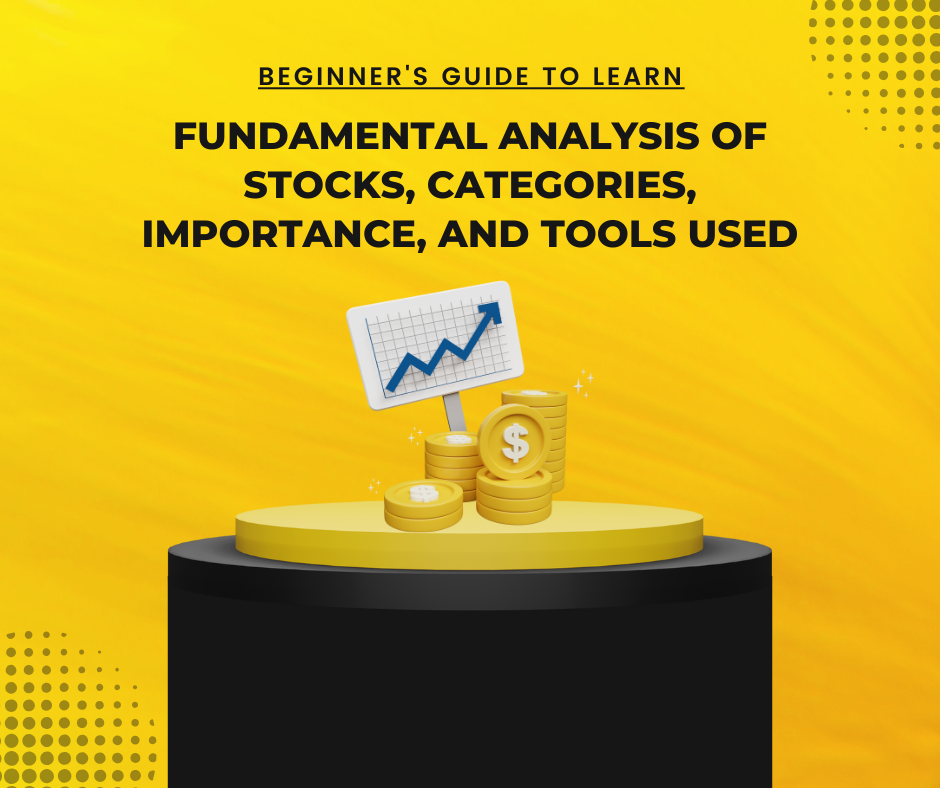
I. Introduction
Welcome to the dynamic realm of equity stock markets, a bustling marketplace where financial opportunities and challenges dance together.
In this guide, we'll not only navigate the ins and outs of the market but also uncover the stories woven into every stock ticker.
A. Definition and Scope of Equity Markets
The equity market, often referred to as the stock market, is the heartbeat of global economies.
Picture it as a vast, interconnected marketplace where investors buy and sell ownership in companies.
Here is equity stock market and it represents more than just transactions—it symbolizes ownership, influence, and potential growth.
In terms of scope, it's not limited to numbers and tickers; it's a dynamic ecosystem shaping the destiny of companies and impacting the lives of investors.
As we explore this financial realm, keep in mind the sheer scale: a global market capitalization exceeding $132 trillion (World Bank, Q3 2023).
In India alone, the market capitalization is a significant $4 trillion (NSE, Dec 2023). The sheer volume of listed companies globally, over 210,000, with around 8,000 in India, highlights the extensive opportunities present (World Bank, NSE).
B. Significance of Equity Trading in Financial Systems
Beyond the numbers, the equity market is a barometer of economic health. It's not just about buying and selling stocks; it's about understanding the heartbeat of industries.
The market sentiment influences corporate decisions and investor strategies alike. Think of it as a financial mood ring, reflecting the collective sentiment of investors globally.
In this intricate dance of financial systems, statistics come alive. The average daily trading volume globally is a staggering $4.7 trillion, with India contributing approximately $112 billion (Statista, Dec 2023).
These aren't just numbers; they represent the constant ebb and flow of financial transactions that shape the global economic landscape.
II. Basics of Equity Trading
A. Understanding Stocks
Stocks, the protagonists of our financial narrative, represent ownership in companies. Think of them as certificates of participation in the success and growth of businesses.
The term stock market basics takes us back to the essence: understanding the language of tickers, dividends, and market dynamics.
B. Market Participants and their Roles
Picture the equity market as a bustling theater with a diverse cast. Retail investors, institutional players, brokers, and market makers—each playing a unique role that contributes to the unfolding drama.
This is not just about transactions; it's a collaborative performance where each participant adds their flair.
C. Brokers and Exchanges
Brokers and exchanges are the stage managers ensuring a smooth performance. These are the entities facilitating the buying and selling of stocks.
Just like in a theater production, their roles are crucial in orchestrating the seamless flow of transactions.
III. Concepts of Equity Valuation
A. Fundamental Analysis: Unveiling the Company's Story
In the intricate narrative of equity markets, understanding stocks isn't just about price movements; it's about delving into the company's story.
Enter the stage of fundamental analysis, a tool that lets investors peel back the layers and grasp the essence of a company's journey.
Fundamental Analysis
Picture fundamental analysis as the backstage tour of our financial play.
Investors, donning the hat of detectives, use this approach to uncover the intricacies that drive a company's success.
Beyond stock prices, it's about scrutinizing the fundamental factors that form the foundation of a business.
Demystifying Financial Statements: Chapters of a Company's Story
Within fundamental analysis, financial statements are the chapters of a company's story. The balance sheet, income statement, and cash flow statement serve as scripts that reveal a company's financial performance.
Each line is a sentence, each section a paragraph, narrating the company's past, present, and potential future.
As we explore the concept of fundamental analysis, imagine it as reading between the lines of a gripping novel—the plot twists, the character development, and the climax that determines the company's fate in the market.
IV. Instruments in Equity Markets
A. Common Stocks: The Heartbeat of the Market
Let's dive into the instruments that orchestrate the rhythm of the equity market. Common stocks, the heartbeat of this financial orchestra, represent ownership in a company.
When you own a common stock, you own a piece of the business—complete with voting rights and a share in profits.
B. Preferred Stocks: The Melody of Fixed Dividends
Now, let's introduce another instrument playing a different tune—preferred stocks. These financial notes carry a promise of fixed dividends, making them a harmonious addition to the symphony of equity instruments.
C. Exchange-Traded Funds (ETFs): The Ensemble of Diversification
Our exploration of instruments continues with the ensemble cast of Exchange-Traded Funds (ETFs).
These investment vehicles bring diversification to the forefront, allowing investors to own a collection of assets in a single package.
D. American Depository Receipts (ADRs): The Global Harmony
Our journey through instruments takes us to a global stage with American Depository Receipts (ADRs).
These financial instruments allow investors to access foreign stocks without the hassle of cross-border transactions.
V. Equity Market Indices: Navigating the Market Symphony
A. Major Global Indices: S&P 500, FTSE 100, Nikkei 225, Sensex, Nifty 50
Embark on a journey through the market symphony, where the beat is set by major global indices. These indices, like musical notes on a global scale, reflect the pulse of their respective economies.
B. Calculation and Significance: Decoding the Index Score
Ever wondered how these indices create their melodies? The calculation is a symphony of market capitalization, stock prices, and various methodologies, culminating in a score that defines market trends.
C. Tracking and Benchmarking: Investor's Compass in the Equity Jungle
For investors navigating the equity jungle, these indices serve as a compass. Tracking and benchmarking against them allows investors to gauge their portfolio performance and adjust their strategies accordingly.
VI. Initial Public Offerings (IPOs): Unveiling New Financial Chapters
A. Process and Stages: The Grand Unveiling
Step into the world of Initial Public Offerings (IPOs), where companies take center stage to unveil new financial chapters.
This process involves the transition from private to public, allowing investors to become part of a company's growth story.
B. Benefits and Risks for Investors: Navigating the IPO Landscape
While IPOs present exciting opportunities, they come with their share of benefits and risks. Understanding this landscape is crucial for investors looking to participate in the IPO extravaganza.
VII. Risks in Equity Investing: Navigating the Rollercoaster
Embarking on equity investment involves embracing the thrill of market risk. With a global daily trading volume of around $4.7 trillion (Statista, Dec 2023), market dynamics create a dynamic playground where risk and reward dance hand in hand.
VIII. Understanding Dividends: Harvesting the Fruits of Investment
In the financial orchard of equity investing, dividends are the ripe fruits. As companies thrive, they share their prosperity with investors through regular payouts. Globally, dividends and splits are integral, representing stability in a dynamic market.
IX. Introduction to Derivatives: Unraveling Financial Alchemy
A. Futures and Forwards: The Art of Financial Prediction
Welcome to the realm of financial alchemy—derivatives. Here, investors engage in the art of predicting the future, using instruments like futures and forwards to navigate the twists and turns of the financial landscape.
B. Options Trading: The Power of Choice
In the derivatives playbook, options trading emerges as the power of choice. Investors wield the ability to choose whether to buy or sell an asset at a predetermined price, introducing flexibility and strategic maneuvers to the investment game.
C. Swaps in Equity Markets: The Financial Barter System
Enter the financial barter system of equity markets—swaps. Here, investors engage in agreements to exchange cash flows, interests, or assets, creating a dynamic landscape where financial arrangements take on various forms.
X. Role of Derivatives in Risk Management
A. Hedging Strategies: Safeguarding the Financial Story
In the unpredictable landscape of the equity market, risk is the unsung antagonist. Enter the role of derivatives—a set of financial instruments designed to manage and mitigate risks.
Think of derivatives as the superheroes, donning capes to protect investors from the unexpected twists and turns in their financial narratives.
Derivatives and Risk Management
Derivatives aren't just a term; it's a shield against the uncertainties that lurk in the financial shadows.
As the global market capitalization takes the center stage at $132 trillion (World Bank, Q3 2023), derivatives emerge as the strategic tool in the hands of investors, ready to navigate the complexities of risk.
Futures and Options: The Dynamic Duo
Within the realm of derivatives, futures and options take the spotlight. Imagine them as the dynamic duo, each with its unique powers.
Futures contracts offer a glimpse into the future, allowing investors to lock in prices and mitigate the impact of market fluctuations.
Options, on the other hand, provide the freedom to choose, giving investors the right (but not the obligation) to buy or sell assets at a predetermined price.
Statistics Guiding the Plot: Derivatives in Action
The global derivatives market, surpassing $1 quadrillion in notional value (IMF, 2023), showcases the magnitude of these financial instruments.
In India, where market dynamics are influenced by factors like high retail investor participation and regulatory frameworks, derivatives play a crucial role in risk management (NSE).
Real-World Applications: Safeguarding Portfolios
Derivatives aren't just theoretical concepts; they are real-world tools applied by investors to safeguard their portfolios. Picture an investor using futures to hedge against potential losses in a volatile market or an options strategy designed to protect against adverse price movements.
XI. Measuring Stock Market Performance
A. Return on Investment (ROI): The Financial Scoreboard
In our exploration of equity markets, understanding performance metrics is akin to deciphering the scoreboard in a thrilling sports match. At the heart of this financial game lies Return on Investment (ROI), the numerical reflection of success or setback in the stock market arena.
Decoding ROI: The Financial Scorecard
Think of ROI as the financial scorecard, where investors gauge the success of their ventures. The formula is straightforward:
ROI = (Current Value of Investment - Cost of Investment) / Cost of Investment.
This numerical expression encapsulates the financial journey, revealing whether investments are thriving or trailing.
Navigating Volatility with ROI
In a market where volatility is the norm, ROI becomes a reliable navigator. Imagine an investor assessing the ROI of a diverse portfolio, strategically balancing high-risk, high-reward assets with stable, long-term investments.
Real-World Application: ROI in Action
Beyond theory, ROI finds its place in the real-world playbook of investors. Picture an investor evaluating the success of a stock pick, calculating the ROI to determine whether the venture was a triumph or a learning experience.
XII. Behavioral Finance in Equity Markets: Decoding Investor Behavior
A. Investor Biases: The Human Element in Financial Decisions
Dive into the fascinating realm of behavioral finance, where investor decisions are not just rational choices but a reflection of human biases. Understanding these biases is key to decoding the intricate dance of emotions in the equity market.
Investor Biases
Investor biases aren't just psychological quirks; they're the undercurrents shaping market trends. With global market capitalization growing ~20% YTD 2023 in emerging markets like India (World Bank), recognizing these biases becomes crucial for navigating the ebbs and flows.
Emotional Influences: Unraveling Investor Decisions
Imagine investor decisions as a complex tapestry woven with emotions. Behavioral finance unravels this tapestry, revealing how emotions like fear, greed, and overconfidence influence decisions, often leading to market trends that defy traditional economic models.
Contrarian Opportunities: Recognizing Behavioral Patterns
Investor biases create contrarian opportunities for astute market participants. Recognizing behavioral patterns allows investors to position themselves strategically, capitalizing on market movements driven not just by fundamentals but also by the collective psychology of market participants.
B. Herding Behavior: The Market's Synchronized Dance
In the equity market's grand ballroom, herding behavior takes center stage. Investors, like dancers in a synchronized performance, often follow the crowd, creating momentum that shapes market trends.
Herding Behavior
Herding behavior isn't just a market phenomenon; it's the synchronized dance of investors. In emerging markets like India, where market capitalization grew ~20% YTD 2023 (World Bank), herding amplifies trends, leading to momentum that can either fuel or challenge traditional market expectations.
Momentum Trading: Riding the Wave
Picture momentum trading as riding a wave created by herding behavior. Investors who understand this dance can strategically ride the wave, capitalizing on trends driven not just by fundamentals but by the collective movement of the crowd.
Contrarian Strategies: Navigating Against the Current
Contrarian investors navigate against the current of herding behavior. Recognizing when the crowd's enthusiasm reaches extremes allows contrarians to position themselves for potential reversals, creating opportunities in market dynamics.
C. Implications for Market Trends: The Human Touch on Financial Charts
Behavioral finance isn't just a theoretical concept; it leaves a tangible imprint on financial charts. Understanding the implications of investor behavior provides insights into market trends that go beyond traditional economic analysis.
Market Dynamics: Integrating Behavioral Insights
Market dynamics become a richer tapestry when behavioral insights are integrated. Whether it's the surge in India's market capitalization or the global derivatives market surpassing $1 quadrillion (IMF, 2023), understanding how human behavior interacts with these trends offers a holistic view of market forces.
Long-Term vs Short-Term Trends: Balancing Act
Behavioral finance influences both short-term and long-term market trends. Recognizing the balance between rational decision-making and emotional influences allows investors to navigate the landscape, making informed decisions that align with their financial objectives.
Adaptive Strategies: Thriving in a Dynamic Environment
Investors who embrace behavioral finance decode market trends and adapt their strategies accordingly. Thriving in a dynamic environment requires recognizing shifts in investor sentiment and adjusting investment approaches.
XIII. Regulatory Framework in Equity Markets
A. Securities and Exchange Commission (SEC) and Equivalents
Navigate the regulatory landscape governing equity markets. Learn about institutions like the Securities and Exchange Board of India (SEBI) and their global equivalents, ensuring market integrity and investor protection.
B. Compliance and Enforcement
Understand the importance of compliance with regulatory standards. Explore how regulatory bodies enforce rules and regulations to maintain a fair and transparent marketplace.
C. Investor Protection Measures
Explore the measures in place to protect investors. From disclosure requirements to anti-fraud provisions, understand how regulatory frameworks safeguard the interests of market participants.
XIV. Globalization of Equity Markets: Connecting Financial Horizons
A. Cross-Border Trading: Bridging Global Economies
Step into the globalized landscape of equity markets, where borders blur and financial transactions transcend geographical boundaries. Cross-border trading is the cornerstone of a connected world, creating a seamless flow of capital across diverse economies.
Cross-Border Trading
Cross-border trading isn't just about transactions; it's the bridge connecting global economies. With over 210,000 listed companies globally and ~8,000 in India (World Bank, NSE), the equity market becomes a global bazaar where investors explore opportunities beyond their local borders.
Diversification Opportunities: Beyond Home Turf
Imagine diversification not limited by borders. Globalization opens avenues for investors to explore opportunities beyond their home turf, creating a diversified portfolio that spans industries, regions, and economic cycles.
Challenges and Opportunities: Navigating Global Dynamics
While globalization presents opportunities, it also brings challenges. Investors must navigate global dynamics, understanding the impact of geopolitical events, economic shifts, and regulatory variations across regions.
B. Impact of Global Events on Markets: The Ripple Effect
In the interconnected web of global equity markets, events in one part of the world create ripples across continents. Understanding the impact of global events on markets is essential for investors navigating international dynamics.
Global Events
Global events aren't just headlines; they're catalysts shaping market trends. From the S&P 500 in the U.S. to the Nifty 50 in India, global events have a ripple effect, creating momentum that extends beyond borders.
Real-Time Reactions: The Power of Information
In a digital age where information flows at the speed of light, market reactions to global events are swift. Picture an investor in India reacting in real time to a geopolitical event in Europe, adjusting their portfolio to align with emerging opportunities and risks.
XVI. The Future of Equity Markets: A Glimpse Beyond the Horizon
A. Technological Advancements: Shaping Tomorrow's Market
The future of equity markets is intricately tied to technological advancements. From blockchain to AI-powered trading algorithms, technology is reshaping the way markets operate and how investors engage with them.
Technological Advancements
Technological advancements aren't just innovations; they're the architects of the future market. With AI-powered trading platforms and blockchain-based systems, investors can access real-time data, execute trades seamlessly, and optimize decision-making.
Blockchain and Decentralized Finance
Picture a market where blockchain and decentralized finance (DeFi) create transparency and security. The traditional market structures are evolving, and these technologies are leading the way toward a more efficient, decentralized future.
B. Environmental, Social, and Governance (ESG) Investing: Ethical Capitalism
As equity markets evolve, the focus on Environmental, Social, and Governance (ESG) investing is gaining momentum. Investors are no longer just seeking profits; they are aligning their capital with ethical principles, creating a new paradigm of responsible investing.
ESG Investing
ESG investing isn't just a trend; it's a movement shaping the future of capital allocation. Investors are prioritizing companies that not only deliver financial returns but also demonstrate a commitment to sustainability, social responsibility, and ethical governance.
The Rise of Impact Investing
Impact investing is on the rise, creating opportunities for investors to align their financial goals with their values. Picture an investor funding renewable energy projects or supporting companies with strong diversity and inclusion practices.
Long-Term Impact: Redefining Success
In the future, success in the equity market may be measured not just by financial returns but by the positive impact investments have on society and the environment. ESG investing is redefining how investors approach the market, creating a new era of ethical capitalism.
XVIII. Future Trends in Equity Markets
A. Artificial Intelligence in Stock Analysis: The Rise of the Machines
In this evolving narrative of equity markets, the future is shaped by the rise of artificial intelligence (AI) in stock analysis.
Imagine a world where machines, armed with complex algorithms, analyze stocks, predict market trends, and redefine the landscape of equity trading.
Artificial Intelligence in Stock Analysis
Artificial intelligence in stock analysis isn't a mere phrase; it's a paradigm shift. As the global market capitalization takes the center stage at $132 trillion (World Bank, Q3 2023), AI becomes the catalyst, offering insights and predictions beyond traditional methods.
Machines at Work: How AI Transforms Stock Analysis
Picture a scenario where machines tirelessly process vast datasets, identify patterns, and make predictions with unprecedented accuracy.
AI isn't just a tool; it's a transformation in how we understand, analyze, and interact with the stock market.
Data-Driven Revolution: AI's Dependence on Comprehensive Data
In this revolution, data becomes the lifeblood. Comprehensive data from sources like Statista, Bloomberg, and The Economist are the fuel powering AI algorithms.
The Economist's insights (Aug 2023) into the future of equity markets emphasize the critical role data plays in shaping AI-driven predictions.
Global Impact: AI's Borderless Influence
AI's impact knows no borders. It's a borderless influence discussed by The Economist, shaping not only how individual investors but entire markets worldwide approach stock analysis.
The future is one where AI reshapes decision-making, making it more informed and precise.
B. Decentralized Finance (DeFi): Redefining Market Participation
As we peer into the future, decentralized finance (DeFi) emerges as a disruptor, redefining how individuals participate in equity markets.
Think of a financial landscape where traditional intermediaries take a back seat, and individuals directly engage in financial activities using decentralized technologies like blockchain.
Decentralized Finance (DeFi)
Decentralized finance isn't just a buzzword; it's a revolution. With a global market capitalization looming at $132 trillion (World Bank, Q3 2023), DeFi becomes the disruptor, challenging traditional financial structures.
Direct Participation: How DeFi Empowers Individuals
Envision a scenario where individuals, armed with blockchain technology, directly participate in financial activities.
DeFi isn't just a concept; it's a paradigm shift empowering individuals with unprecedented access and control over their financial decisions.
Statistical Insight: DeFi's Growing Presence
Let's ground this in numbers. The statistic of $1 quadrillion in the global derivatives market (IMF, 2023) underscores the magnitude of traditional financial structures.
In contrast, DeFi, discussed by The Economist, represents a paradigm where individuals have more agency and influence.
Challenges and Opportunities: Navigating the DeFi Landscape
The future isn't without challenges. While DeFi opens new doors, it also poses questions about regulation, security, and the potential for systemic risks.
The Economist's insights (Aug 2023) shed light on the challenges and opportunities that come with this decentralized future.
XIX. Summary
A. Key Takeaways
Global Market Dynamics: The global market capitalization exceeding $132 trillion (World Bank, Q3 2023) showcases the vastness of the equity landscape.
It's a realm where economic forces, investor sentiments, and market trends converge.
Data-Driven Decision-Making: Our exploration delved into the importance of data from sources like Statista, Bloomberg, and The Economist.
In a world driven by information, staying informed is not just an advantage but a necessity.
Diverse Instruments and Risks: From common stocks to derivatives, we navigated through a myriad of instruments and associated risks.
Understanding the nuances is crucial for investors crafting resilient and well-informed strategies.
Technological Transformations: Algorithmic trading, high-frequency trading, artificial intelligence, and decentralized finance emerged as transformative forces.
The future of equity markets is intricately woven with technological advancements, reshaping how we analyze stocks and engage in financial activities.
Global and Local Dynamics: Whether exploring the unique features of India's equity market or understanding the global derivatives market exceeding $1 quadrillion (IMF, 2023), the interplay of global and local dynamics is evident. Investors must navigate both arenas for comprehensive insights.
B. Importance of Equity Markets in a Diversified Portfolio
As we wrap up our exploration, it's crucial to emphasize the role of equity markets in a diversified portfolio. Here's why:
Growth Potential: Equity markets offer unparalleled growth potential, allowing investors to participate in the success stories of thriving companies and emerging industries.
Risk Mitigation: While risks are inherent, a diversified portfolio with a mix of stocks, ETFs, and other instruments helps mitigate the impact of market fluctuations and uncertainties.Income Generation: Dividends, stock appreciation, and strategic investments contribute to income generation, making equity markets a valuable component for wealth creation.
Innovation and Opportunity: The constant evolution of equity markets introduces new instruments, technologies, and investment opportunities. Staying engaged allows investors to capitalize on innovations and trends.
In conclusion, equity markets are not just financial landscapes; they are arenas of opportunity, growth, and strategic wealth creation.
As we bid farewell to this exploration, remember that understanding, adaptability, and a well-informed approach are your allies in the ever-evolving world of equity trading.
XX. Frequently Asked Questions (FAQs)
1. What exactly is an equity stock market?
The equity stock market is like the grand marketplace for businesses. It's where shares of companies are bought and sold.
Investors become stakeholders, owning a piece of the companies they invest in. Think of it as a global stage where the success stories of businesses unfold.
2. How does one start investing in stocks for the first time?
Starting to invest in stocks can be overwhelming, but it's like taking the first step into a world of possibilities.
Begin by researching, understanding your risk tolerance, and consider consulting a financial advisor. The process might seem daunting, but it's a journey worth taking.
3. What are the risks involved in equity investing?
Ah, the unavoidable risks! Equity investing comes with its share of uncertainties, such as market volatility, sector-specific risks, and regulatory changes.
Understanding these risks is crucial; it's like navigating the twists and turns of a financial roller coaster.
4. How can one mitigate risks in equity investing?
Mitigating risks is like having a safety net while walking the tightrope. Diversification is key—spread your investments across different stocks, industries, and instruments. Keep an eye on market trends and, most importantly, stay informed.
5. Tell me more about the role of derivatives in risk management.
Derivatives, like financial superheroes, help manage risks. They include futures and options, offering ways to hedge against market fluctuations.
It's like having a shield that protects your investments in the face of uncertainty.
6. What's the future of the stock market?
Ah, the crystal ball question! While we can't predict the future with absolute certainty, we can look at trends.
Artificial intelligence, decentralized finance, and technological innovations are set to play starring roles. The script is still unfolding, and investors need to stay tuned.
7. Any advice for navigating the stock market's twists and turns?
Navigating the stock market is like sailing through uncharted waters. Stay informed, diversify your portfolio, and be ready to adapt.
Remember, it's not just about weathering the storms; it's about seizing opportunities in the changing tides.
8. Is the stock market only for experts, or can beginners participate too?
The stock market is for everyone, not just the experts. Beginners, seasoned investors, and everyone in between can participate.
It's about learning, adapting, and growing. Think of it as a learning experience where each trade is a lesson.
9. How can one stay updated with market trends and insights?
Staying updated is like having a compass in the market wilderness. Follow reputable financial news sources, explore market reports from organizations like Statista and The Economist, and maybe even join online communities. Knowledge is your compass in the dynamic world of finance.
Comments (0)
Categories
Recent posts


Tips on how to select the Best Share ...
18 Sep 2024
Best Intraday Trading Strategies for ...
24 Jun 2024
Fundamental Analysis Of Stocks, ...
4 Jul 2024



